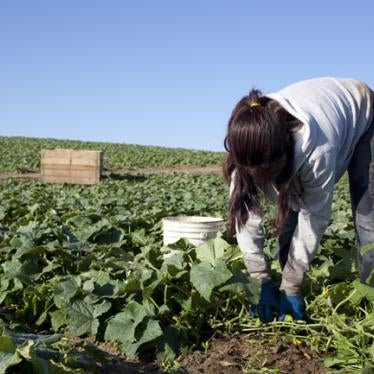An important national conversation is happening on the harsh reality of child labor in the United States after it was revealed that many unaccompanied immigrant children are involved in hazardous work. But a group of often disregarded US child workers—those working in agriculture—have been largely left out of the discussion and desperately need greater protection.
The US Department of Labor has seen a sharp increase in child labor violations in recent years. It recently found over 100 children working dangerous, overnight shifts in meatpacking facilities. In late February, the Biden administration committed to step up child labor enforcement efforts.
Enforcement is essential, but it can’t help children who are working dangerous jobs that are completely legal.
Over the last decade, I have researched the dangerous conditions children face while working in US agriculture. I interviewed a 17-year-old boy who had two fingers sliced off in an accident with a mowing machine. A 13-year-old girl felt so faint working 12-hour-shifts in the heat that she had to hold herself up with a tobacco plant. An eighth grader said his eyes itched and burned when a farmer sprayed pesticides in a field near his worksite.
These were not children working on their own families’ farms. These children were working as hired laborers, often on large commercial agribusiness operations.
Unlike situations in which children are working in meatpacking plants or on construction sites, almost none of the child labor I documented violated US law or regulations. That’s because children working in agriculture lack even the basic legal protections given to children working in all other workplaces in the US.
Longstanding exemptions in US labor law allow children as young as 12 to work legally as hired laborers on commercial farms for unlimited hours with a parent’s permission. At 16, children working on farms can do tasks considered particularly hazardous. In every other workplace, children have to be 16 to work full-time and 18 to do hazardous work.
The agricultural exemptions in US labor law date back to New Deal-era legislation. They were intended to exclude Black workers from the rights and protections given to white workers, preserving a system that allowed employers to continue to profit off of racist exploitation, denying Black workers opportunities for economic advancement. The exemptions continue to have racist impacts, with Latinx children and families now most harmed.
The weak protections are of great concern because more children die working in agriculture than in any other sector. Like the children I interviewed, thousands are injured or sickened each year while working on farms.
Members of Congress will soon reintroduce the Children’s Act for Responsible Employment and Farm Safety, or the CARE Act, legislation to provide children working in agriculture with the same protections as children working in other sectors. The legislation would raise the minimum age for children’s work on farms, and set the hazardous work age at 18, in line with all other kinds of work. The bill has never reached a floor vote. Congress should enact the legislation without delay.
Even without passage of a new law, under the leadership of Acting Secretary Julie Su, the Labor Department has a responsibility to update narrow, 50-year-old regulations governing hazardous work in agriculture. It should open new rulemaking on the topic swiftly.
Enacting better protections at the federal level is more important than ever as at least 10 states have moved to roll back child labor protections and put younger children to work in more dangerous conditions.
A strong legal framework will not end child labor overnight. Farmworkers need a living wage so they can support their families, and workers must be able to exercise their rights to organize and collectively bargain. Strong social protection programs can also provide relief to families experiencing economic insecurity.
But strong child labor laws are the foundation for protecting children from hazardous and exploitative work and set reasonable expectations for employers and companies to follow. It gives labor inspectors basic minimum standards to enforce. And most important, in line with international human rights law, strong laws affirm that children have a right to be protected from dangerous work that could harm their health and development or interfere with their schooling.
Child farmworkers in the US lack that basic foundation.
U.S. leaders will not fix the country’s child labor problem unless they commit to protecting all children from exploitative and hazardous work, including those working on farms.
Margaret Wurth is a senior children’s rights researcher at Human Rights Watch.
The views expressed in this article are the writer's own.









